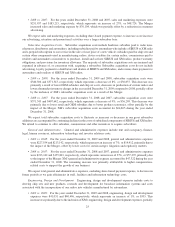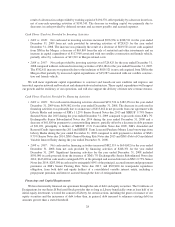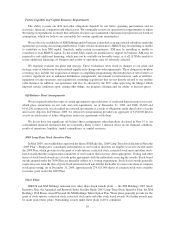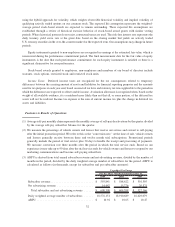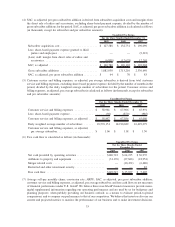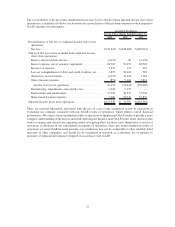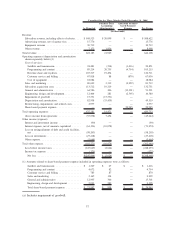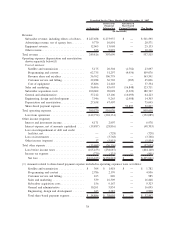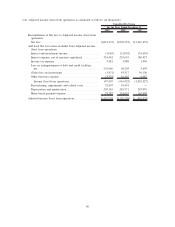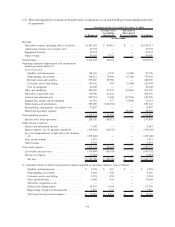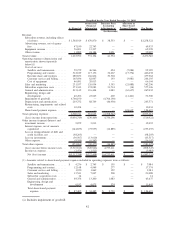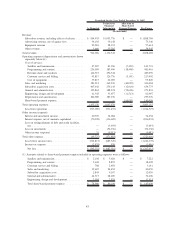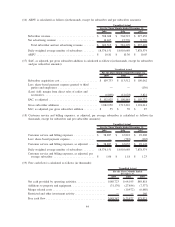XM Radio 2009 Annual Report Download - page 139
Download and view the complete annual report
Please find page 139 of the 2009 XM Radio annual report below. You can navigate through the pages in the report by either clicking on the pages listed below, or by using the keyword search tool below to find specific information within the annual report.We believe the exclusion of share-based payment expense in our calculations of SAC, as adjusted, per gross
subscriber addition and customer service and billing expenses, as adjusted, per average subscriber is useful
given the significant variation in expense that can result from changes in the fair market value of our common
stock, the effect of which is unrelated to the operational conditions that give rise to variations in the components
of our subscriber acquisition costs and customer service and billing expenses. Specifically, the exclusion of
share-based payment expense in our calculation of SAC, as adjusted, per gross subscriber addition is critical in
being able to understand the economic impact of the direct costs incurred to acquire a subscriber and the effect
over time as economies of scale are reached.
These non-GAAP financial measures are used in addition to and in conjunction with results presented in
accordance with GAAP. These non-GAAP financial measures may be susceptible to varying calculations; may
not be comparable to other similarly titled measures of other companies; and should not be considered in
isolation, as a substitute for, or superior to measures of financial performance prepared in accordance with
GAAP.
(8) We refer to net income (loss) before interest and investment income; interest expense, net of amounts
capitalized; income tax expense; loss on extinguishment of debt and credit facilities, net; (gain) loss on
investments; other expense (income); restructuring, impairments and related costs; depreciation and amorti-
zation; and share-based payment expense as adjusted income (loss) from operations. Adjusted income (loss)
from operations is not a measure of financial performance under U.S. GAAP. We believe adjusted income (loss)
from operations is a useful measure of our operating performance. We use adjusted income (loss) from
operations for budgetary and planning purposes; to assess the relative profitability and on-going performance of
our consolidated operations; to compare our performance from period-to-period; and to compare our perfor-
mance to that of our competitors. We also believe adjusted income (loss) from operations is useful to investors
to compare our operating performance to the performance of other communications, entertainment and media
companies. We believe that investors use current and projected adjusted income (loss) from operations to
estimate our current or prospective enterprise value and to make investment decisions.
Because we fund and build-out our satellite radio system through the periodic raising and expenditure of large
amounts of capital, our results of operations reflect significant charges for interest and depreciation expense.
We believe adjusted income (loss) from operations provides useful information about the operating perfor-
mance of our business apart from the costs associated with our capital structure and physical plant. The
exclusion of interest and depreciation and amortization expense is useful given fluctuations in interest rates and
significant variation in depreciation and amortization expense that can result from the amount and timing of
capital expenditures and potential variations in estimated useful lives, all of which can vary widely across
different industries or among companies within the same industry. We believe the exclusion of taxes is
appropriate for comparability purposes as the tax positions of companies can vary because of their differing
abilities to take advantage of tax benefits and because of the tax policies of the various jurisdictions in which
they operate. We believe the exclusion of restructuring, impairments and related costs is useful given the non-
recurring nature of these expenses. We also believe the exclusion of share-based payment expense is useful
given the significant variation in expense that can result from changes in the fair market value of our common
stock. To compensate for the exclusion of taxes, other expense (income), depreciation and amortization and
share-based payment expense, we separately measure and budget for these items.
There are material limitations associated with the use of adjusted income (loss) from operations in evaluating
our company compared with net loss, which reflects overall financial performance, including the effects of
taxes, other (income) expense, depreciation and amortization, restructuring, impairments and related costs and
share-based payment expense. We use adjusted income (loss) from operations to supplement GAAP results to
provide a more complete understanding of the factors and trends affecting the business than GAAP results
alone. Investors that wish to compare and evaluate our operating results after giving effect for these costs,
should refer to net loss as disclosed in our consolidated statements of operations. Since adjusted income (loss)
from operations is a non-GAAP financial measure, our calculation of adjusted income (loss) from operations
may be susceptible to varying calculations; may not be comparable to other similarly titled measures of other
companies; and should not be considered in isolation, as a substitute for, or superior to measures of financial
performance prepared in accordance with GAAP.
34



